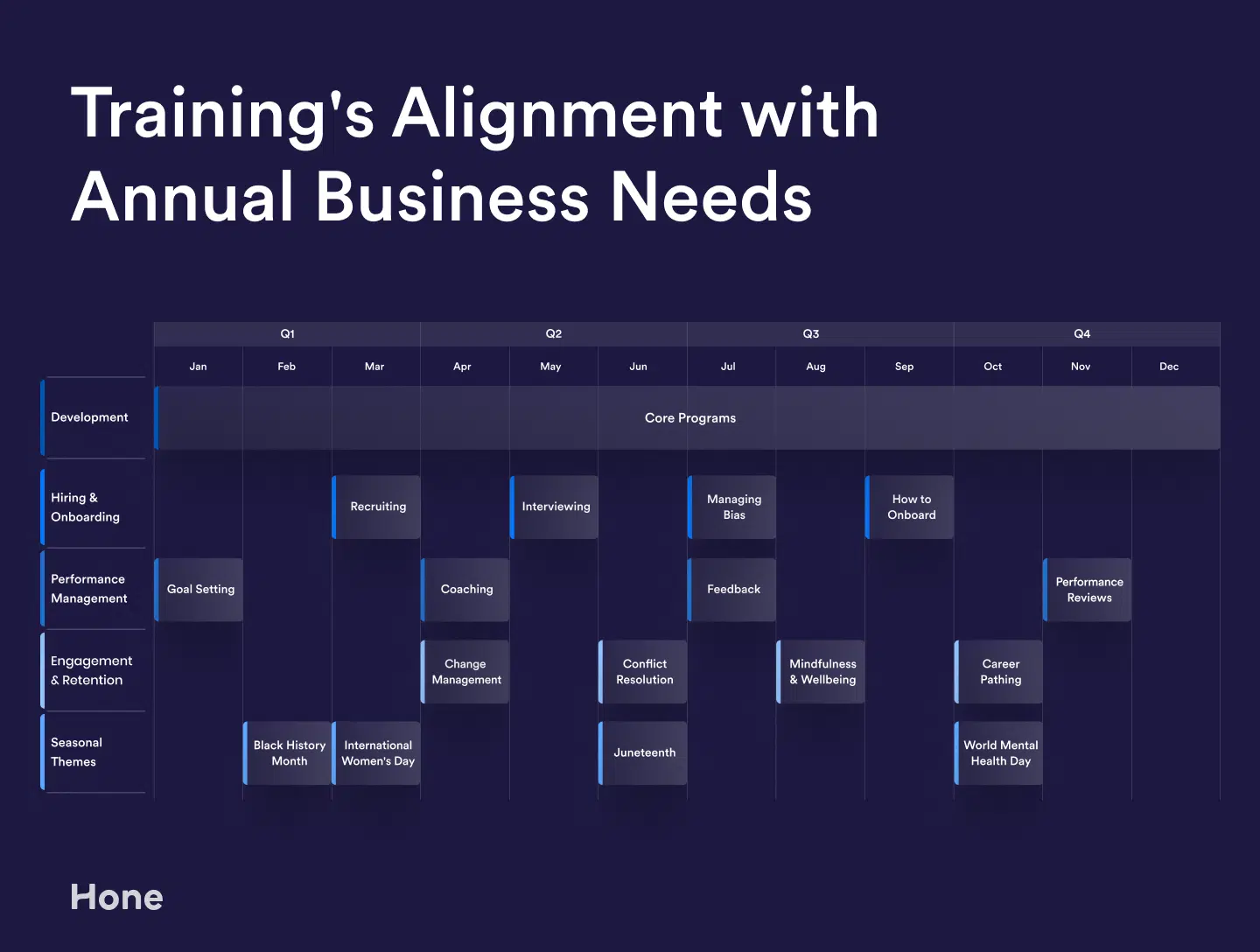Managers can either be the glue that holds your teams together, or one of the main reasons employees leave your organization. Often, managers can be the ones overlooked the most when it comes to building line items in your spending for training programs. Creating a manager training budget shows your L&D team is focused on building a strong leadership team, engaged in continuous learning and improvement.
Let’s walk through the essential steps for how to create manager training budgets, and what should be included.
What is a Manager Training Budget?
Manager training budgets are an outline for all expenses and expected returns in relation to team development, continued learning, and company value initiatives. The goal of manager training budgets is to provide a roadmap for executive leaders to evaluate the investment of trainings and programs aimed at developing your workforce effectively.
One of the first steps to building an effective manager training budget is understanding which costs to include. Identifying specific spending categories will help keep you organized and prioritize where to use your money.
Manager training budget setup will vary by each organization. Most companies have either a centralized L&D budget or they separate funds by geographic regions or business units. If the budget is centralized, it’s important to understand which costs to associate for each type of employee and team.
Employee Training Costs
Training budgets include materials costs reflected in courses, certifications, or other direct requirements for certain organizations and specialized roles. ATD (Association for Talent Development) describes direct learning expenditures with these three categories: internal services, learning suppliers, and tuition reimbursement. Every handout, LMS, external course offering, etc., need to be measured and accounted for to provide an effective training and development ROI.
Each L&D leader wants their initiatives and training investments to pay off, but as materials costs add up, ask yourself – what are some ways you can reduce spending while maintaining quality learning opportunities? If your leadership team has granted you limited funding, consider which costs would be the first to go while also maintaining a positive experience and outcome for your employees.
How to Create a Manager Training Budget
What are the critical factors that you need your managers to know? These will vary by individual and type of leaders in each functional area. As a starting point, consider the company values and objectives you are looking to achieve and what skills or concepts are most important for managers to communicate. Give your managers the tools to inspire their teams through your company guidelines and mission while also discovering learning habits and specific courses needed for individual employees.
Write down some of the key initiatives you’ve done in the past. Take into consideration the costs you’ve spent and the ROI of your previous campaigns, courses, or training programs. Then, calculate the delta between where your current management levels are operating and the goals you’ve set for the training environment.
Separate your direct and indirect costs, and define clear allocation for each line item, category, and overall spend. This helps your management team understand how much they’ll have to spend externally on themselves and any internal needs for training. To stay competitive and keep top talent, HR leaders should be offering comprehensive management training and benefits. Discover industry norms for spending on a manager training budget for your size company, and given the goals you are trying to achieve.
How Much Do Companies Spend on a Manager Training Budget on Average?
Training and L&D remain an important line items in an organization’s budget. Companies that understand the value and importance of effective training programs will continue to attract and retain high performers.
Recently, the average training spend for organizations ranges between $1000 – $2000 (ATD) per employee. Last year, companies spend more than one-quarter (28%) of expenses on learning suppliers, defined as companies that provide consulting services, external content development and licenses, and outside, non-staff trainers.
The Importance of a Manager Training Budget
Providing a healthy budget for manager and leadership training has a lasting ripple effect within organizations. If managers learn new skills, are retrained, or have a consistent path for learning, they feel more confident in leading their teams. Managers who complete training programs learn how to influence decision-making, create efficient processes, and empower teams and your organization to be at their best.
Budgets for manager training help show the ROI of specific programs. This goes a long way in telling an effective story of how your L&D team impacts revenue and employee engagement. By using data and qualitative analysis, your team can uncover where to spend time and money on effective training for each leader. Upon evaluating your results, you can report your findings to board members, executive leaders, and each manager to discover improvement methods and training opportunities.
Discover the ROI for Training Managers
A simple formula can be used to evaluate the business impact that training has on your management team.
First, attribute specific costs for the lines of business, regions, or types of management you will be considering.
Then, you’ll need to align on metrics that describe the benefits to your company. These benefit factors can take time to correctly identify and define for your organization since teams and company missions vary.
The main considerations to keep in mind for benefitsare behavioral changes in managers, increases in revenue, and objective attainment. These will be common indicators that your training is performing well or that improvement or realignment is necessary. Sometimes you don’t get it right the first time, and that’s okay.
Improvement takes time, investment, and good evaluation tools. To get a complete grasp on your current training program ROI, check out our ROI calculator for manager training. We hope it helps inform you on what you’ll need to set aside for your manager training budget.
Creating an Effective Manager Training Program
Designing a manager training budget helps your organization develop leaders that will make a lasting impact on your team and deliver on business goals. Be sure to take both internal and external factors into your budget, including direct material costs and any time associated with compensation and limited normal working business hours.
Hone takes the weight off your shoulders by tracking your training program effectiveness and giving your team essential manager training classes that scale with your company. Discover how your team can make a great impact on company culture and improve the ROI of your training programs.
Schedule a demo with our team to learn more about the Hone platform.














